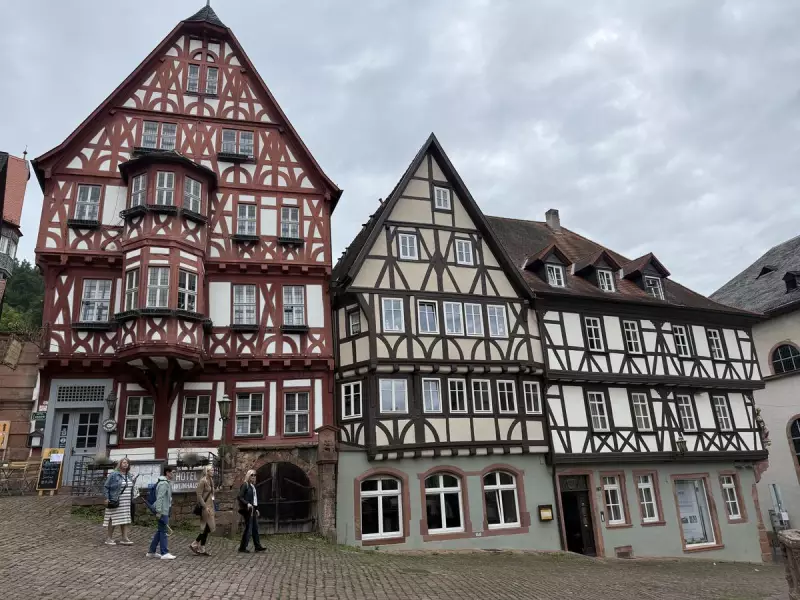
Stepping Back in Time: Miltenberg's Medieval Charm
Another day brings another medieval marvel as our ship docks in the picturesque Bavarian town of Miltenberg, nestled along the banks of the River Main. Unlike many German destinations requiring complex transport, this excursion begins with a simple walk from the vessel, where our guide Dorothea meets us to begin our journey into history.
A Town Built on Trade and Timber
Miltenberg's origins trace back to the 13th century, when its strategic riverside position established it as a vital trading hub. The town's prosperity grew from multiple sources including wine grapes, fishing, shipping operations, timber harvesting, and sandstone quarrying. This economic golden age continued until the early 1800s when Miltenberg became part of Bavaria and lost its traditional trading privileges, leading to a significant economic downturn.
Ironically, this financial decline proved to be the town's salvation during World War II. Because Miltenberg lacked military, industrial or infrastructural importance, Allied forces showed little interest in targeting it. While countless German cities suffered devastating bombings, Miltenberg's historic buildings remained completely intact, preserved through obscurity.
Architectural Treasures and Their Stories
Today, Miltenberg is celebrated for its distinctive half-timbered houses that line the cobblestone streets. Dorothea shares a fascinating German saying still used today: calling someone "stone rich" means they have substantial wealth. Only the affluent could afford stone-built properties, while poorer residents constructed houses using wood frames filled with a mixture of dirt, clay, dung and fermented urine.
The transformation from these humble beginnings to the beautifully preserved structures we see today is remarkable. The timber detailing on building exteriors features highly decorative patterns, with many adorned with window boxes overflowing with vibrant greenery and flowers. One of the town's oldest buildings bears a carved date of 1333 - though the timbers have shifted over centuries, making the structure slightly crooked, it stands as a testament to medieval craftsmanship.
Among the architectural treasures is Gasthof Zum Riesen (the giant's tavern), one of Germany's oldest hotels with official records dating to 1411. Rebuilt in 1590 in the half-timbered Renaissance style, the establishment has hosted numerous famous guests including Napoleon Bonaparte, Empress Maria Theresa, composer Richard Strauss, and possibly even Elvis Presley during his US Army service in Germany during the 1950s.
Dark History and Personal Connections
The town's history isn't all charming architecture and famous guests. During 17th century witch trials, Miltenberg witnessed at least 200 executions, including two innkeepers from Zum Riesen who were burned at the stake. The square facing the hotel appears in historical records as "the witches' dance floor."
Dorothea leads us up a narrow alley to show the site of the town's last remaining witch hut, no longer in use. Between 1593 and 1597, approximately twenty single-cell jails were constructed between the town wall and moat specifically to imprison those accused of witchcraft. Miltenberg's final execution for witchcraft occurred in 1630.
In a more personal moment, Dorothea reveals her own connection to the town, pointing to a well-preserved half-timbered house. "My mother and father lived here. I was born in this house," she explains. After growing up and moving away, she completed a full circle by purchasing her family home years later and now resides there again.
She's not the only one with deep roots in Miltenberg. Following the town's trading decline, it evolved into a hub for craftworkers with butchers, bakers, brewers, blacksmiths and shoemakers establishing businesses. These skills passed through generations, with some bakeries and breweries opened in the 19th century still remaining family-owned today.
Market Square and Local Encounters
During our exploration, Dorothea encounters a friend carrying a platter of jelly lollies. "His shop has lovely sweets. Try the black ones, they are the best," she recommends. The cute penguin-shaped black and white candies prove delicious, prompting several group members to visit his shop for purchases.
After her informative tour concludes with directions back to the ship, I return to what I consider Miltenberg's most picturesque area: Old Market Square. The steep cobbled street features five-storey half-timbered houses painted in muted but colourful tones, all in excellent condition.
At the square's center stands an octagonal red sandstone Renaissance fountain constructed in 1583, surrounded by begonias, petunias and lobelia. The central column features carved dancing putti, most facing outward except for one cherub facing the pillar with a bare bottom exposed. Local theories suggest this might be directed toward a town official who cheated sculptor Michael Juncker, or perhaps toward St Jakobus church as protest against religious authorities. The true reason remains unknown, possibly just the sculptor's cheeky humor.
My wandering reveals another architectural gem: a doorway blending art nouveau and medieval styles with intricately carved red sandstone featuring two oak trees complete with tiny acorns, topped by a bearded man wearing an opulent headdress. The wooden door within showcases floral carvings and metalwork tulips and scrolls, leaving me wishing Dorothea remained to explain its story.
As I return to the ship, enjoying a few jelly penguins from our sweet encounter, I reflect on Miltenberg's remarkable preservation - a medieval time capsule saved by historical circumstance, now offering visitors an authentic journey into Germany's past.





